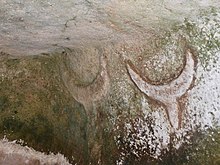Domus de Janas

Domus de Janas (Sardinian: "House of the Fairies" or, alternatively, "House of Witches") are a type of pre-Nuragic chamber tombs found in Sardinia. They consist of several chambers quarried out by the people of the San Ciriaco through Ozieri cultures[1] and subsequent cultures, resembling houses in their layout.

Built mostly between 3400 and 2700 BC, they date to the late Neolithic, Chalcolithic and early Bronze Age. A necropolis of them at the site of Anghelu Ruju, near Alghero, consists of 38 tombs. Other large sites are those of Montessu, near Villaperuccio, and of Sant'Andrea Priu at Bonorva. Many other domus de janas can be found throughout the island, with the exception of Gallura (where the deceased were usually buried in megalithic circles, such as that those of Li Muri).
The shape of the internal chambers can vary from that of a rounded hut with conical or triangular ceiling. The walls are often decorated with reliefs or etchings depicting magical and religious symbols such as spirals, zig-zag motifs and bull's horns.[2]
Carved or painted false doors appear in about 20 tombs mostly located in northwestern Sardinia,[3]: 137–9 an example being some of the tombs of the necropolis of Anghelu Ruju, which are variously datable from the Ozieri to the Bonnanaro cultures (c.3200 – 1600 BCE).[4] These false doors usually appear on the back wall of the main chamber, and are represented by horizontal and vertical frames and a projecting lintel. Sometimes the door is topped with painted or carved U-shaped bull horns, inscribed inside each other in a variable number.
The corpses, painted with red ochre like the tomb's walls, were buried together with common life objects, jewels and tools. According to archaeologist Giovanni Lilliu, they were buried under shells of molluscs; according to other theories, they were left outside the tomb, being put inside only after they had reduced to a skeleton.
Gallery[]

Domus de Janas, Necropolis of Anghelu Ruju

Interior of one of the Domus de Janas of Sant'Andrea Priu, Bonorva.

Domus de Janas of S'Elighe Entosu.

Entrance of the domus de janas of Genna Salixi, Ruinas

Domus de Janas in Lotzorai
Interior of a Domus de Janas
Necropolis of Arzolas de Goi, Nughedu Santa Vittoria

Pre-Nuragic false door topped with bull horns, from Putifigari

Plan of the Tomb of the Chief, Necropolis of Sant'Andrea Priu.
See also[]
References[]
- ^ Domus de Janas, Portale Sardo Archived March 4, 2016, at the Wayback Machine
- ^ "Archived copy". Archived from the original on 2016-03-04. Retrieved 2015-07-16.
{{cite web}}: CS1 maint: archived copy as title (link) - ^ Contu, Ercole (2006). La Sardegna preistorica e nuragica. Volume 1: la Sardegna prima dei nuraghi [Prehistoric and Nuragic Sardinia. Volume 1: Sardinia before the nuraghi] (in Italian). Carlo Delfino editore. ISBN 88-7138-421-0.
- ^ Demartis, Giovanni Maria (1986). La Necròpoli di Anghelu Ruju. Sardegna Archeologica 2. Carlo Delfino editore.
- Domus de Janas on the Atlas Obscura.
Bibliography[]
- Giovanni Lilliu, La civiltà dei Sardi dal neolitico all'età dei nuraghi, Torino, Edizioni ERI, 1967
- AA.VV. La civiltà in Sardegna nei secoli, Torino, Edizioni ERI
- AA.VV., Ichnussa. Sardegna dalle origini all'età classica, Milano, 1981
- Alberto Moravetti, Guide archeologiche Sardegna 2, 1995
| Wikimedia Commons has media related to Domus de janas. |
- Burial monuments and structures
- Archaeology of death
- Archaeological sites in Sardinia








